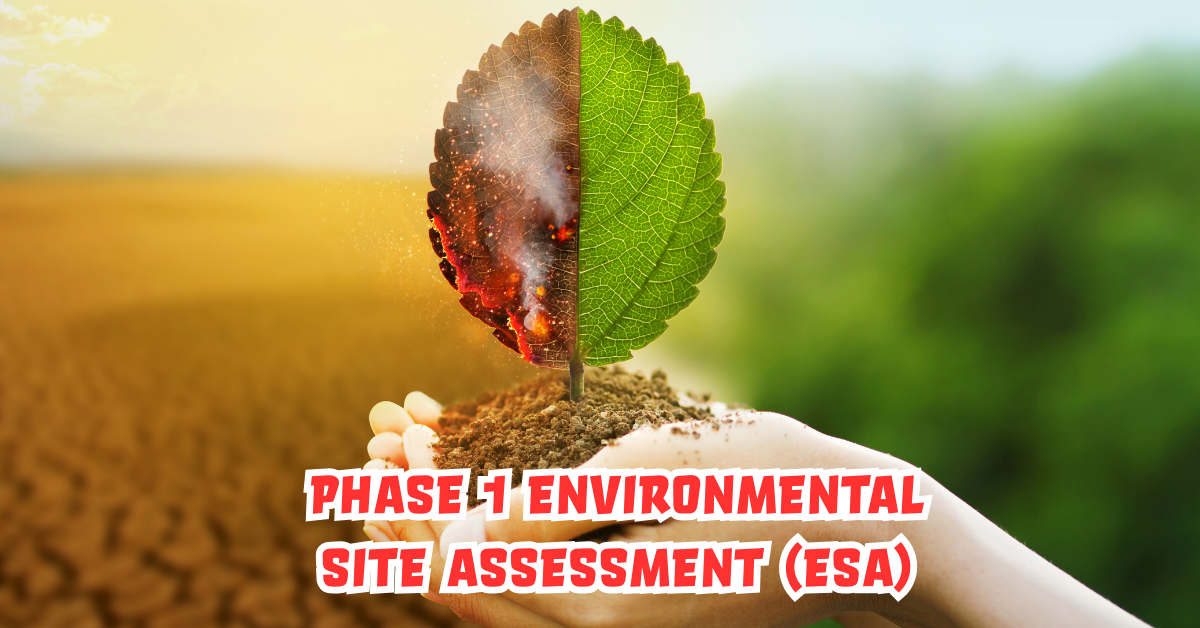When considering the purchase of a property—whether it is commercial, industrial, or even vacant land—one of the most overlooked yet crucial steps is the environmental due diligence process. The very first stage of this process is called a Phase 1 Environmental Site Assessment (ESA), a detailed evaluation designed to identify potential contamination risks and environmental liabilities associated with a property. For buyers, lenders, and developers, this assessment can be the difference between a profitable investment and a costly mistake. The cost of a Phase 1 ESA is a frequent concern for stakeholders, especially those navigating real estate for the first time.
In simple terms, a Phase 1 ESA is an investigation conducted by an environmental professional who reviews the property’s history, surrounding land uses, regulatory records, and visible conditions on site. It is not intrusive—meaning no soil or water samples are taken—but it is comprehensive enough to highlight red flags. These assessments are mandated or strongly recommended by lenders, government programs, and responsible investors.
The cost of a Phase 1 Environmental Site Assessment depends on several variables, including property size, complexity of land use, geographic location, consultant expertise, and urgency of reporting. While the typical range can vary widely, understanding the factors that influence cost can help stakeholders make informed financial and environmental decisions. As one environmental consultant once said, “An assessment is not just a report; it is insurance against hidden environmental debt.”
This article provides a complete and updated guide to Phase 1 ESA costs, diving into the process, influencing factors, typical price ranges, benefits, and modern relevance. It is designed for property buyers, real estate developers, lenders, and even students of environmental science who want a clear, detailed picture of what this essential step entails.
What is a Phase 1 Environmental Site Assessment?
A Phase 1 ESA is essentially a risk evaluation. Its primary objective is to identify Recognized Environmental Conditions (RECs)—situations where hazardous substances or petroleum products might be present due to past or present use. Unlike a Phase 2 ESA, which involves sampling soil or groundwater, Phase 1 focuses on research and observation.
The process usually includes:
- Historical Records Review – Analyzing old maps, aerial photographs, directories, and building records.
- Regulatory Database Search – Checking if the property or neighboring parcels have ever been flagged for contamination.
- Site Reconnaissance – Walking the property to look for visible signs of contamination like chemical storage, distressed vegetation, or underground tanks.
- Interviews – Speaking with property owners, occupants, or local officials who might know about past site activities.
- Report Preparation – Documenting findings, identifying RECs, and recommending next steps.
As a lender once noted, “Banks don’t just want collateral; they want clean collateral.” This illustrates why Phase 1 ESAs are indispensable for transactions involving millions of dollars and long-term community impacts.
Factors That Influence Phase 1 ESA Cost
The cost of a Phase 1 ESA is not fixed; it varies widely depending on multiple factors. Understanding these can help buyers and developers anticipate expenses more accurately.
Property Size and Complexity
A small, single-lot property with no prior industrial activity is easier to assess compared to a multi-acre industrial site with decades of manufacturing history. Larger and more complex properties require deeper research and longer site visits, which directly affect cost.
Location and Accessibility
Urban properties often come with higher costs due to complex historical use and denser records. Remote properties, on the other hand, may require additional travel and logistical expenses.
Historical Use of Land
If a property has been used for gas stations, dry cleaners, or factories, the assessment will involve more intensive research. In contrast, land with agricultural use may demand less scrutiny but still requires review for pesticide residues.
Consultant Experience
Hiring a reputable firm with certified environmental professionals will likely cost more but ensures credibility with lenders. Inexperienced consultants might charge less, but their reports may lack the rigor necessary to satisfy financial institutions.
Turnaround Time
Standard Phase 1 ESA reports may take two to four weeks. If a client requests expedited services—sometimes within five business days—the cost can increase significantly.
Regulatory Requirements
Some states or municipalities may have additional requirements that extend the scope of work, thus increasing costs.
Typical Cost Range of Phase 1 ESA
While costs vary, most assessments fall into a predictable range. To give readers a clear sense of budget expectations, here is an overview.
Table 1: Typical Cost Range of Phase 1 ESA
| Property Type | Approximate Cost Range (USD) | Notes on Complexity |
|---|---|---|
| Small commercial property | $1,500 – $2,500 | Simpler history, fewer records |
| Vacant land | $1,200 – $2,000 | May vary if agricultural use is present |
| Large industrial facility | $3,000 – $6,500 | More records, higher risk of RECs |
| Multi-parcel real estate | $4,000 – $8,000 | Requires broader review |
| Expedited ESA (any property) | +25% to +50% of base cost | Faster turnaround raises cost |
These ranges reflect current industry averages, though local market conditions may shift pricing.
Why Phase 1 ESA is Worth the Cost
The price of a Phase 1 ESA may feel steep for first-time investors, but it pales in comparison to the potential liabilities avoided. Without an ESA, a buyer could unknowingly acquire land contaminated with petroleum or hazardous waste. Cleaning such contamination can cost hundreds of thousands—or even millions—of dollars.
Moreover, ESAs provide lenders with confidence. Many banks will not finance a purchase unless a clean Phase 1 ESA report is submitted. Developers also use these reports to secure grants or tax incentives related to brownfield redevelopment.
As one property investor shared, “The report saved us from buying a property sitting on top of an old chemical dump. It was the best $3,000 we ever spent.”
Step-by-Step Process of a Phase 1 ESA
Understanding the process helps explain where costs come from.
Table 2: Step-by-Step Breakdown of Phase 1 ESA
| Step | Activities Included | Timeframe | Cost Impact |
|---|---|---|---|
| Historical Review | Maps, aerials, archives | 3–5 days | Moderate |
| Regulatory Database Search | Federal, state, local records | 2–4 days | Moderate |
| Site Visit | Walkthrough, visual inspection | 1 day | Low |
| Interviews | Owners, tenants, officials | 2–3 days | Low |
| Report Writing | Compilation, findings, recommendations | 1–2 weeks | High |
Each step requires professional expertise, particularly the report-writing phase, which represents the largest portion of labor costs.
The Modern Relevance of Phase 1 ESAs
Today’s real estate environment is more complex than ever. With stricter environmental regulations and increased awareness of sustainability, Phase 1 ESAs are not merely bureaucratic hurdles—they are essential tools in responsible property development.
Developers increasingly use ESA findings to make proactive environmental decisions, such as restoring contaminated lands into usable green spaces. Municipalities rely on these reports to ensure community safety, while lenders see them as risk management.
Furthermore, with the growing focus on ESG (Environmental, Social, and Governance) reporting, companies are more inclined to highlight their diligence in environmental risk assessments. A comprehensive ESA demonstrates a company’s commitment to ethical development and environmental responsibility.
Conclusion
The cost of a Phase 1 Environmental Site Assessment is best viewed not as an expense but as an investment in risk management, compliance, and sustainable property ownership. Ranging typically between $1,200 and $6,500 depending on property type and complexity, the assessment provides critical insights that safeguard buyers and lenders from hidden environmental liabilities.
While costs may vary, the peace of mind and financial protection offered by a thorough ESA far outweigh the price tag. In today’s property market, where environmental awareness and regulatory compliance are stronger than ever, skipping this process is a gamble that rarely pays off.
Ultimately, a Phase 1 ESA is not just about cost—it is about long-term security, reputation, and financial stability. For anyone entering a property transaction, whether large or small, this assessment should be considered as vital as the property deed itself.
FAQs
1. How long does a Phase 1 ESA take to complete?
Typically, it takes 2–4 weeks. Expedited services can shorten this to a few days at a higher cost.
2. Is a Phase 1 ESA always required by law?
Not always. However, lenders and government-backed loans often require it as part of due diligence.
3. Can I use a cheaper consultant for my ESA?
Yes, but it is risky. Inadequate reports may not satisfy banks or protect you from liability.
4. What happens if the Phase 1 ESA finds contamination?
The next step is a Phase 2 ESA, which involves soil and groundwater testing to confirm contamination levels.
5. Do residential properties need Phase 1 ESAs?
Typically, only if they were previously industrial or commercial sites, or if lenders demand extra diligence.











